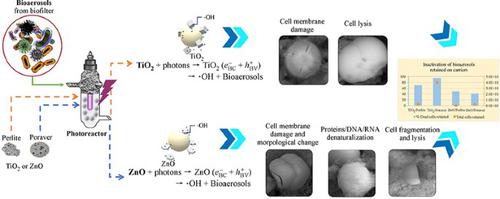Frontiers of Environmental Science & Engineering ( IF 6.4 ) Pub Date : 2020-12-17 , DOI: 10.1007/s11783-020-1335-9 Mariana Valdez-Castillo 1 , Sonia Arriaga 1

|
Bioaerosols are airborne microorganisms that cause infectious sickness, respiratory and chronic health issues. They have become a latent threat, particularly in indoor environment. Photocatalysis is a promising process to inactivate completely bioaerosols from air. However, in systems treating a continuous air flow, catalysts can be partially lost in the gaseous effluent. To avoid such phenomenon, supporting materials can be used to fix catalysts. In the present work, four photocatalytic systems using Perlite or Poraver glass beads impregnated with ZnO or TiO2 were tested. The inactivation mechanism of bioaerosols and the cytotoxic effect of the catalysts to bioaerosols were studied. The plug flow photocatalytic reactor treated a bioaerosol flow of 460 × 1 06 cells/m3air with a residence time of 5.7 s. Flow Cytometry (FC) was used to quantify and characterize bioaerosols in terms of dead, injured and live cells. The most efficient system was ZnO/Perlite with 72% inactivation of bioaerosols, maintaining such inactivation during 7.5 h due to the higher water retention capacity of Perlite (2.8 mL/gPerlite) in comparison with Poraver (1.5 mL/gPerlite). However, a global balance showed that TiO2/Poraver system triggered the highest level of cytotoxicity to bioaerosols retained on the support after 96 h with 95% of dead cells. SEM and FC analyses showed that the mechanism of inactivation with ZnO was based on membrane damage, morphological cell changes and cell lysis; whereas only membrane damage and cell lysis were involved with TiO2. Overall, results highlighted that photocatalytic technologies can completely inactivate bioaerosols in indoor environments.
中文翻译:

生物气溶胶细胞对浸渍在珍珠岩和多孔载体上的 ZnO 和 TiO 2 的光催化失活的响应
生物气溶胶是空气传播的微生物,会导致传染病、呼吸系统和慢性健康问题。它们已成为潜在威胁,尤其是在室内环境中。光催化是一种很有前途的方法,可以使空气中的生物气溶胶完全失活。然而,在处理连续气流的系统中,催化剂可能部分损失在气态流出物中。为了避免这种现象,可以使用支撑材料来固定催化剂。在目前的工作中,测试了四种使用浸渍有 ZnO 或 TiO 2的珍珠岩或 Poraver 玻璃珠的光催化系统。研究了生物气溶胶的失活机理和催化剂对生物气溶胶的细胞毒作用。活塞流光催化反应器处理的生物气溶胶流量为 460 × 1 0 6 个细胞/m 3空气,停留时间为 5.7 秒。流式细胞术 (FC) 用于根据死细胞、受伤细胞和活细胞来量化和表征生物气溶胶。最有效的系统是 ZnO/珍珠岩,其生物气溶胶失活率为 72%,由于与 Poraver(1.5 mL/g 珍珠岩)相比,珍珠岩(2.8 毫升/克珍珠岩)具有更高的保水能力,因此在 7.5 小时内保持这种失活。然而,全球平衡表明,TiO 2/Poraver 系统在 96 小时后对保留在支持物上的生物气溶胶触发了最高水平的细胞毒性,其中 95% 的死细胞。SEM和FC分析表明,ZnO失活的机制是基于膜损伤、细胞形态变化和细胞裂解;而TiO 2仅涉及膜损伤和细胞裂解。总体而言,结果强调光催化技术可以完全灭活室内环境中的生物气溶胶。


























 京公网安备 11010802027423号
京公网安备 11010802027423号